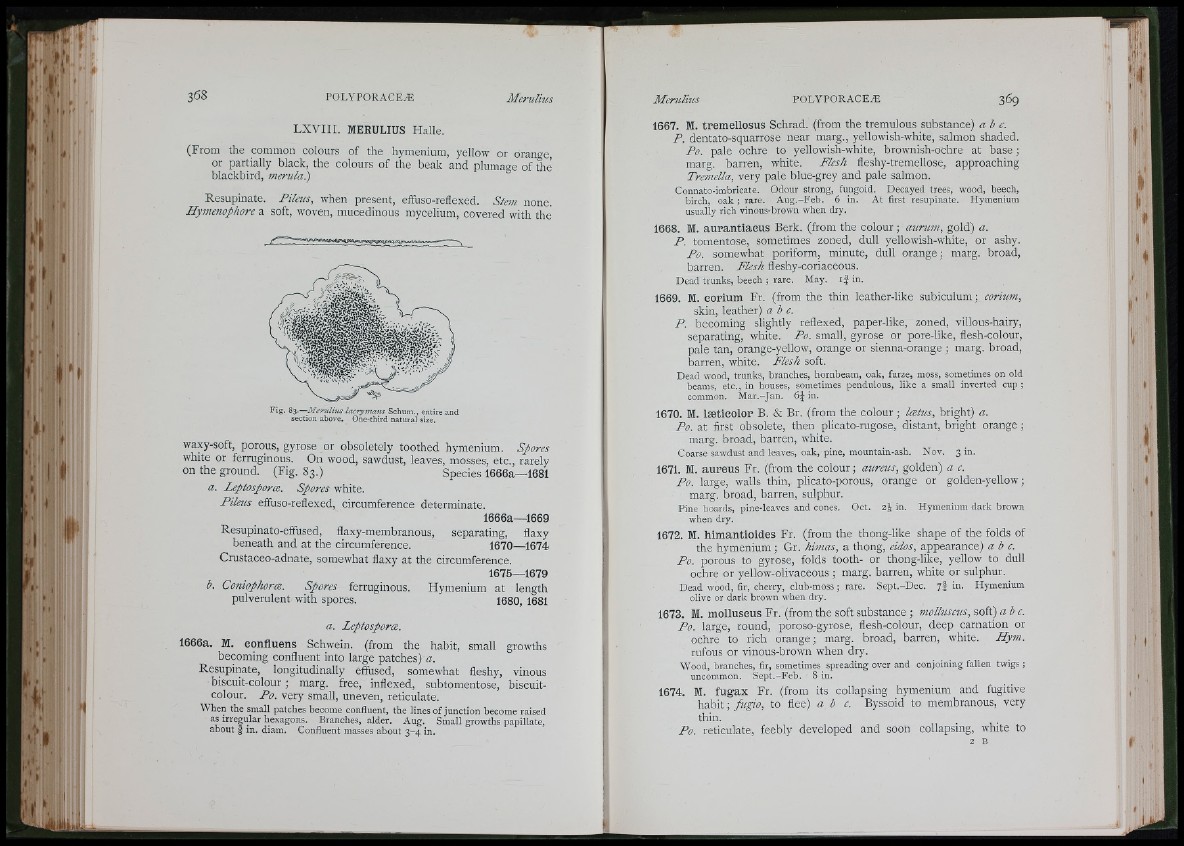
f!
ti'
n
4 1 -
k .
t
Mi
r
LXVIII. MERULIUS Halle.
(From the common colours of the hymenium, yellow or orange,
or partially black, the colours of the beak and plumage of thè
blackbird, inerula)
Resupinate. Pileus, when present, effuso-reflexed. Stem none.
Hymenophore a soft, woven, mucedinous mycelium, covered with the
F ig . 85.—M eru liu s lacryjuatts Schum., entire and
section above. One-third natural size.
waxy-soft, porous, gyrose or obsoletely toothed hymenium. Spores
white or ferruginous. On wood, sawdust, leaves, mosses, etc., rarely
on the ground. (Fig. 83.) Species 1666a—1681
a. Ikptosporce. Spores white.
Pileus effuso-reflexed, circumference determinate.
1666a—1669
Resupinato-effused, flaxy-membranous, separating, flaxy
beneath and at the circumference. 1670—1674
Crustaceo-adnate, somewhat flaxy at the circumference.
1675—1679
b. Coniophorm. Spores ferruginous. Hymenium at length
pulverulent with spores. 1680, 1681
a. Leptospora.
1666a. M. eonfluens Schwein. (from the habit, small growths
becoming confluent into large patches) a.
Resupinate, longitudinally effused, somewhat fleshy, vinous
biscuit-colour ; marg. free, inflexed, subtomentose, biscuit-
colour. Po. very small, uneven, reticulate.
When the small patches become confluent, the lines of junction become raised
as irregular hexagons. Branches, alder. Aug. Small growths pajrillate,
about I in. diam. Confluent masses about 3-4 in.
1667. M. tremellosus Schrad. (from the tremulous substance) a b c.
P. dentato-squarrose near marg., yellowish-white, salmon shaded.
Po. pale ochre to yellowish-white, brownish-ochre at base;
marg. barren, white. Flesh fleshy-tremellose, approaching
Tremella, very pale blue-grey and pale salmon.
Connato-imbricate. Odour strong, fungoid. Decayed trees, wood, beech,
birch, oak ; rare. Aug.-Feb. 6 in. At first resupinate. Hymenium
usually rich vinous-brown when dry.
1668. M. aurantiaeus Berk, (from the colour; aurum, gold) a.
P. tomentose, sometimes zoned, dull yellowish-white, or ashy.
Po. somewhat poriform, minute, dull orange; marg. broad,
barren. Flesh fleshy-coriaceous.
Dead trunks, beech ; rare. May. i f in.
1669. M. eorium Fr. (from the thin leather-like subiculum; corium,
skin, leather) abc.
P. becoming slightly reflexed, paper-like, zoned, villous-hairy,
separating, white. Po. small, gyrose or pore-like, flesh-colour,
pale tan, orange-yellow, orange or sienna-orange ; marg. broad,
barren, white. Flesh soft.
Dead wood, trunks, branches, hornbeam, oak, furze, moss, sometimes on old
beams, etc., in houses, sometimes pendulous, like a small inverted cup ;
common. Mar.-Jan. 6® in.
1670. M. Isetieolor B. & Br. (from the colour ; latus, bright) a.
Po. at first obsolete, then plicato-rugose, distant, bright orange ;
marg. broad, barren, white.
Coarse sawdust and leaves, oak, pine, mountain-ash. Nov. 3 in.
1671. M. aureus Fr. (from the colour; aureus, golden) a c.
Po. large, walls thin, plicato-porous, orange or golden-yellow;
marg. broad, barren, sulphur.
Pine boards, pine-leaves and cones. Oct. 2® in. Hymenium dark brown
when dry.
1672. M. himantioides Fr. (from the thong-like shape of the folds of
the hymenium; Gr. himas, a thong, eidos, appearance) abc.
Po. porous to gyrose, folds tooth- or thong-like, yellow to dull
ochre or yellow-olivaceous ; marg. barren, white or sulphur.
Dead wood, fir, cherry, club-moss ; rare. Sept.-Dee. yj in. Hymenium
olive or dark brown when dry.
1673. M. molluseus Fr. (from the soft substance ; molluscus, soft) abc.
Po. large, round, poroso-gyrose, flesh-colour, deep carnation or
ochre to rich orange; marg. broad, barren, white. Hym.
rufous or vinous-brown when dry.
Wood, branches, fir, sometimes spreading over and conjoining fallen twigs ;
uncommon. Sept.-Feb. 8 in.
1674. M. fugax Fr. (from its collapsing hymenium and fugitive
habit; fugio, to flee) a b c . Byssoid to membranous, very
thin.
Po. reticulate, feebly developed and soon collapsing, white to